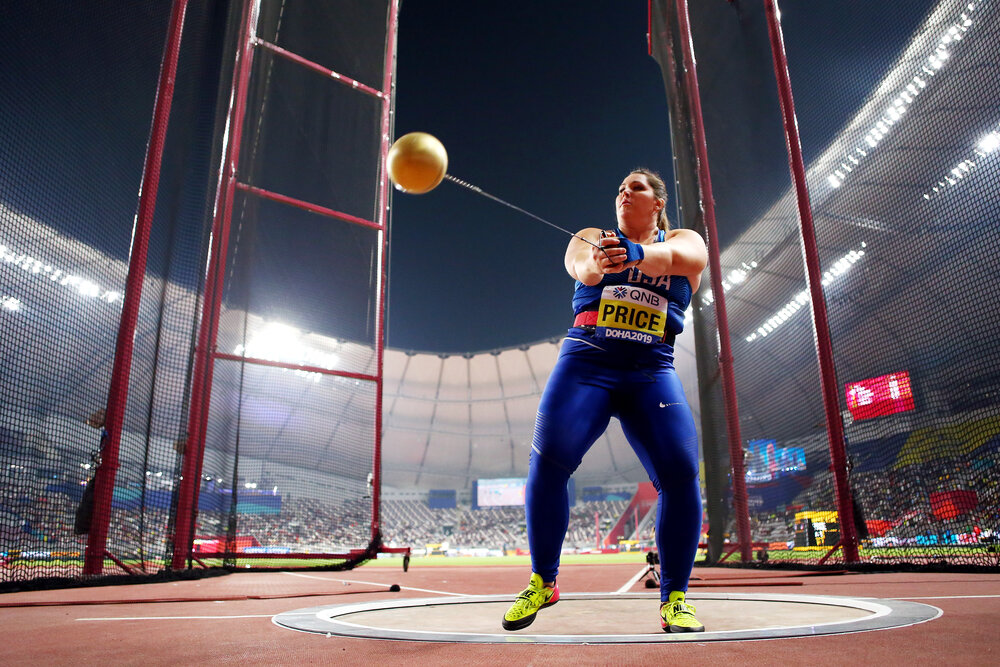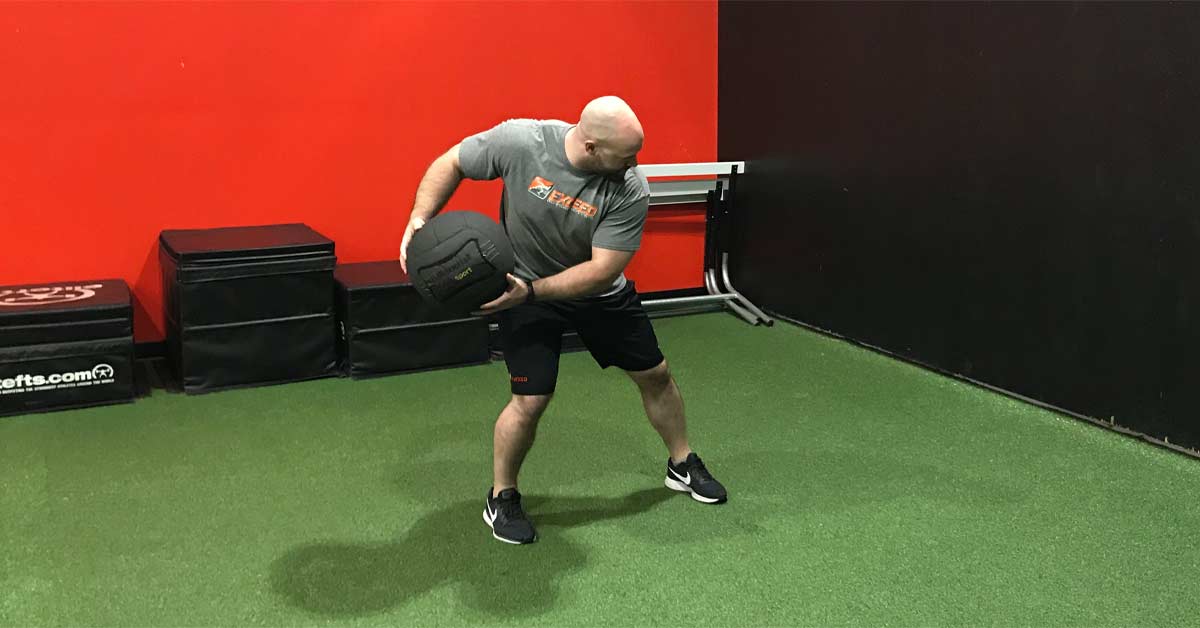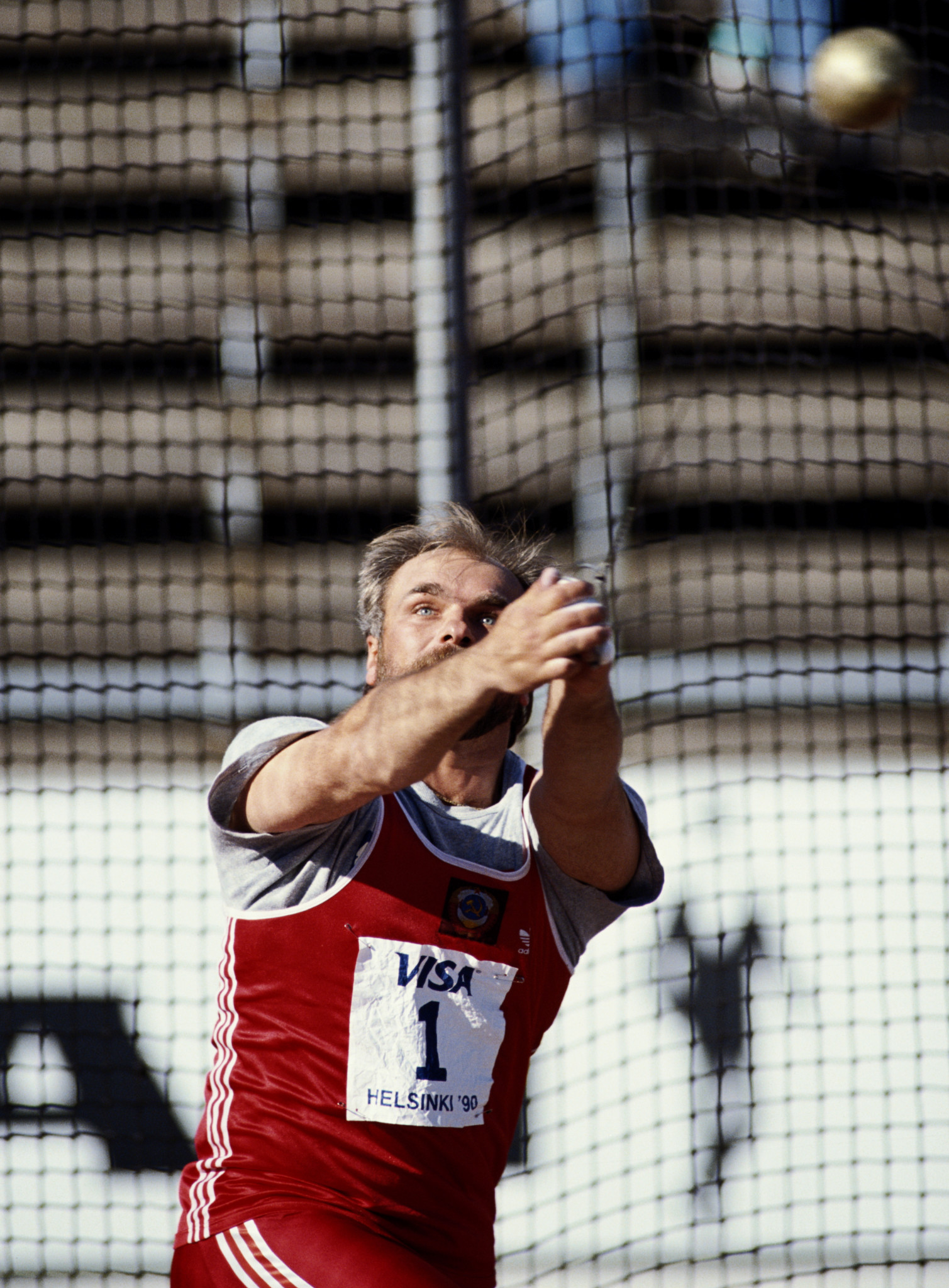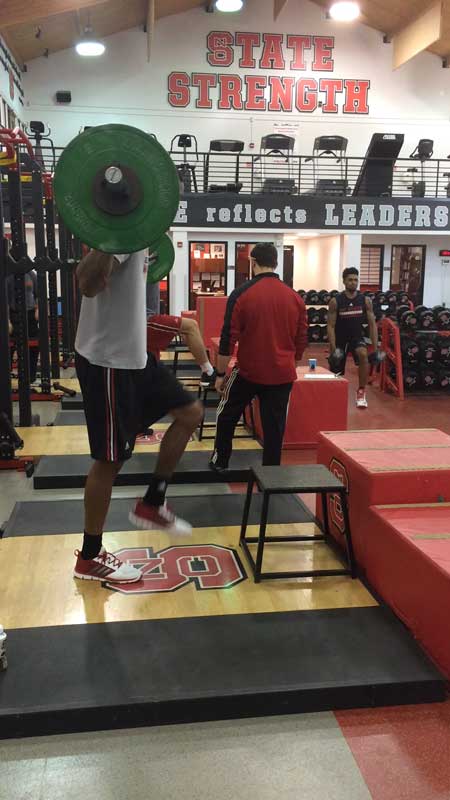Strength Training for the Hammer Thrower
December 16, 2022
Written by Spencer Herrick
This article's objective is to breakdown some notions and ideas regarding how to build and maintain strength for the hammer throw. The average strength coach knows that lifting weights as part of exercise or conditioning for the hammer thrower is vital to the competitions success. I will also gladly admit that learning to throw a hammer effectively, that is, with good form and distance, requires more than just strength training, particularly the free weight lifting component of it.
Even though there are several excellent resistance training exercises that are effective for all throws, I will concentrate on which lifts and routines are most advantageous for the hammer event, in my opinion. The multi-event thrower will then need to consider what could be added to or stressed more in his or her present program. The availability and caliber of facilities and equipment, capacity for training loads, and time restraints will all be important limiting factors. I'll also talk about how to include strength training into periodized training plans and what the main training phases should focus on.
The strength qualities necessary for throwing the hammer will be covered in detail in this article. It is unquestionably helpful to have general strength when attempting to rotate both your body and loft a large round object simultaneously. In the current throwing methodology, lower body (legs) and core stability (lower back, abs, obliques, hip flexors), frequently referred to in strength sports as the body's "power zone," are more crucial than upper body strength. But that does not make upper body strength unimportant.
Strength in the hammer is required to enter into and hold the crucial positions during the throw as well as to balance the hammer's outward pulling power. Due to the constant stress (against the ball) and balancing required for a hammer throw, it is also important to have strong stabilizer muscles in the shoulder girdle and back. A strong finish in a hammer throw involves an explosive upward rising of the legs, hips, back, and arms in a fluid, controlled, forceful motion. This releases the energy stored up in the turns. Finally, maintaining high flexibility and range of motion throughout the throw is crucial—hammer throwing is paradoxically flexible and strong. Funny right, a thrower being flexible? Surprisingly, not at all!
Figure 1: Overhead Squat Mobility
Olympic Lifts for Power Development
The Olympic lifts and their variations (power and hang cleans, and pulls) are used as the basic lifts and exercises for the hammer throw for one reason: they are explosive multi-joint motions that require muscle, tendons, and connective tissue to produce and encapsulate high power output. Olympic lifting exercises prepare and condition the body for the hammer throw, which involves a wide range of coordinated and continuous actions that also requires repeat high power output.
Throwing involves "slow to rapid" movements and strong acceleration that pushes the force-velocity curve to its limits, i.e., tremendous acceleration in a very brief period of time. Explosive power is frequently referred to as "speed-strength" since your options to become more powerful are to be quicker or have greater absolute strength. The x-axis of the force-velocity curve indicates velocity (speed), while the y-axis is force (strength). Olympic lifts and their variations' training benefits boost both speed/quickness and strength, "pushing" the force velocity curve and enhancing the capacity to produce maximum power when needed.
Figure 2: Force Velocity Curve
Why is it important though? Good question, and there are certainly key ideas to understand in order to understand the relationship between what some refer to as "fast" lifts and throwing in general, and unquestionably the hammer throws relationship to Olympic style lifting.
First, if performed correctly, the clean and snatch require you to generate a downward force or push into the ground with your feet to initiate the movement of the bar. Second, extremely strong Olympic-style lifters may exert more force for a longer period of time until they collapse under the bar to catch said bar. The most effective hammer throwers can exert tension for the greatest time before releasing. Third, the high force produced by a big weight is what best summates and hypertrophies fast-twitch fibers, the fibers you need for powerful throwing motions like the hammer. Last but not least, the powerful throwing motion is made possible not only by the strength produced but also by a "summation of forces"; in both the Olympic lift and the throw, the bar or implement accelerates more quickly with each subsequent action.
Strength In Different Planes
We need to be just as balanced in our strength training approach as we are in the ring with the hammer, now that the groundwork has been laid for slinging all this iron around in the gym. While the actual throwing actions in track & field are multi-directional and rotational in the hammer, the fundamental pulling movements are essentially along one plane of motion (vertical). Therefore, it is just as important—if not more so—for the thrower to perform twisting and turning exercises against resistance (using tubing, bars, med balls, plates, dumbbells, paddles, etc.) throughout the actual hammer's motion pathways.
Figure 3: Med Ball Rotational Power
American throwers identify "strength" with a strong bench press and huge back squat due to the influence of football coaches and strength training in high schools and online. But as the phrase goes, many roads lead to Rome. If you think about the throwing events—especially the hammer—your feet are neither staying in one place and exerting force vertically in a single plane nor do they have your bodyweight evenly distributed throughout the throw. Squat, bench, and deadlift movements may be suitable for building foundational or base strength. But you perform numerous single-leg and rotational hip motions as you transition from double to single support, grab the hammer at the top of the orbit, and then transition back to double support. Jump squats, step-ups, and one-leg presses are more powerful exercises that use each leg as the season progresses.
Squat Jumps: The video of Yuri Sedykh performing jump squats with dumbbells during his training is probably one of the images of him that will stick with throwers the longest. When done correctly, this is more of a plyometric exercise where the emphasis is on the upward explosiveness and little time is spent gathering yourself once you make contact with the ground. You may use a lot of weight with just the dumbbells by using lifting straps. Another method involves using an Olympic barbell while in a half- or full-back squat position. You can also complete the same concept with a trap bar. In order to simulate the stance of the hammer throw, proper posture with the chest and head up is crucial, regardless of the weight used.
Step-Ups: The "Russian Squat Routine," which is intended to be inserted three times a week into a six-week cycle of periodized training to develop squat strength (+5% 1RM), is another reason why the Russians are well-known among fans of powerlifting and weightlifting. However, Anatoliy Bondarchuk, a former champion hammer thrower from Russia and current coach, came to the conclusion through research that high step-ups were far more advantageous than the strenuous back squat. First, you never assume the back squat position in throwing or sports; second, a load twice as heavy as what is being lifted is placed on the lower back at the bottom of the squat (as in increased injury potential); and third, the step-up produces more "power" in the thigh and hip.
Step Ups
Sprint and Jump Training: For explosive legs, practice plyometrics (hops, bounds, jumps, etc.) and sprint or hill work. However, during a competitive season when you should be throwing a lot, the aforementioned exercises may be all that most throwers require. Focus on learning a few things well and avoid becoming overtrained and worn out. Those drills, in my opinion, are extra fitness and pre-season preparation for the time-constrained thrower. The Bulgarians discovered that the leg muscularity developed by step ups was comparable to that of athletes who engaged in a lot of sprinting and jumping during training.
The Big Three
The importance of the big three (squat, bench, deadlift) comes back to the idea that hammer throwers need to be able to exert high amounts of force at different velocities. When we talk of hammer throwing and hammer strength training, the Soviets are talked about more than any other nationality. The reasons are obvious when we look at the World Rankings.
For example, in 1986, the Soviets had 54 of the top 100 throwers, including the number 1, 2, 3, 4, 8, 9, 10 performers. The Front and Back Squat, all types of Power Cleans and Clean pulls, and a small amount of heavy pulls or deadlifts are all examples of general weight training performed by the soviets. Bench Press was considered an accessory to be completed daily in training, in variations. Variations of the bench press included incline, decline, pin press, larsen press, Z press, and floor press. All variations I take into account for the training of my throwers.
Figure 4: Soviet Hammer Thrower
Specialized Training Methods
The original creator of the unique strength development training model for throwers is Dr. Anatoliy Bondarchuk. His throwing abilities are unmatched, especially in the hammer. Even though his athletes didn't have the best benches, squats, or cleans, Bondarchuk's emphasis on specialized exercises with the highest dynamic connection to throwing allowed them to break world records and take home gold from other countries.
Figure 5: Dr. Anatoliy Bondarchuk
Bondarchuk classifies exercises into 4 categories, General Preparatory, Special Preparatory, Special Developmental and The Competitive Event.
General Preparatory Exercises are different movements and different systems (muscular and energy) than your event. For example, the shot put is an alactic anaerobic event-very explosive in nature, relying heavily on the legs, trunk, shoulders and arms in a linear or rotational fashion. General exercises for the Shot, Disc, and Hammer would be: Deadlift, Rows, Pullups, Presses and Swings with Dumbbells or Kettlebells, GHRs, Back Raises, Pullups/Chinups, Step Ups, Lunges, etc
Special Preparatory Exercises are the same systems as your event but through different movement patterns. Olympic lifts, Squats, Bench Press Variations, Jumping (Upper and Lower Body) Exercises and Sprints would all be classified as special preparatory exercises for the shot putter and discus thrower. For the hammer thrower the Bench Press would be a GPE.
Special Developmental Exercises are using the same systems through similar systems as your event; similar, not identical. Explosive rotational drills, kneeling throw variations and various single joint actions that duplicate one portion of the sporting action and mirror its velocity and range of motion.
Competitive Exercises are of course the throws and variations of them in more difficult (heavier) and easier (lighter) conditions.
Each category on the list, becomes more specific and will have higher dynamic correspondence to your throwing distances. The Preparatory exercises prepare your bodies to train specifically for your event, while the Developmental exercises simultaneously develop your strength and technique.
It is the highest transfer exercises, Special Developmental and Competitive, that we will focus on here and it is these exercises that will yield the greatest improvements in your throwing. Special Developmental Exercises will consist of explosive drills that occur through the same planes of movement that the throws do and at similar velocities. There are too many exercises to list in this category but here are some video examples to get you moving the right direction:
Video 1: Essential Hammer Throw Special Strength Exercises
Video 2: Discus Specific Power
Specific motor patterns required for successful throwing will be improved through special developmental exercises, which are essential for success at the highest level of sport.
But despite how important SDE work is, the Competitive Exercises will have the greatest impact and take precedence over all other tasks. Throwing implements that are overweight, normal weight, and underweight with varied intensities will be the main component of CE work. You can practice your sport and perfect your technique here and only here.
You will develop your skills using overweight and underweight tools at various force/velocity curve points. Throwers who are typically weak or focused on speed can benefit from using overweight implements, whereas athletes who are typically stronger and slower must use more underweight implements to develop their speed. More information about Bondarchuk is out there, for a great read on him head over to this article by Juggernaut Systems: Thoughts on Bondarchuk
Figure 6: Lasha Talakhadze world record clean and jerk
In the end, it does not matter
I can write about this all day, but in the end, your power and overall dynamic correspondence will correlate to how well you throw in practice and the technique you develop. I hope you are not tired of hearing the expression “ground-up” generation of force, because once you grasp it and train it, you will learn to throw the hammer much more efficiently and effortlessly. You will develop the right kind of “strength” and “power” and not just be an upper body dominant “strength thrower”.
The really successful elite throwers have a relaxed or “loose upper body” that is moving around this tremendous amount of force generated by the lower body while letting the ball be the “engine” around them. Your lifting choices should be predicated upon movements that will improve your throwing. Use controlled, directed movements in your lifting and throwing. Be aware of balance, rhythm and timing in your lifting and throwing. Incorporate plate swings and twists for additional work or specialization. Be a thrower first and then a lifter. Don’t let your strength development quantum leap your technique improvement.
References:











Comments
Post a Comment